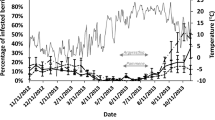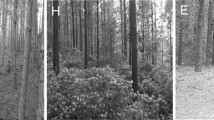Abstract
A study of pre- and post-dispersal damage to the nuts of two beeches,Fagus crenata Blume andF. japonica Maxim., which masted simultaneously, was performed on a single site in Japan. Most insect damage to the nuts before dispersal resulted from boring by lepidopteran larvae, and the level of attack was markedly higher onF. crenata than onF. japonica. Early nut growth ofF. crenata allowed these borers to act as the first attackers on the nuts. Conversely, late nut growth ofF. japonica delayed the attack of borers, and foliage feeders acted as the first attackers instead, chewing on nuts from the outside. The low level of borer attacks on the nuts ofF. japonica in mast years was thought to have been caused by foliage feeders decreasing the amount of food resource available for later attack by borers in lean years. This could then lead to a subsequent depression of the population of borers in mast years. The proportion of nuts damaged by moth larvae was independent of the density of nuts for both beech species. Caching by vertebrates was thought to be the most important factor in post-dispersal damage because the density of nuts of both beech species on the forest floor in March was half the level measured using seed traps in the previous year. However, post-germination damage caused by a fungus was also an important factor. The survival rate of the nuts (including current-year seedlings) in the year after dispersal was independent of the density of dispersed sound nuts in the previous year for both beech species, with the exception of one set of observations (forF. japonica in July).
Similar content being viewed by others
Literature cited
Abe, S., Masaki, T., and Nakashizuka, T. (1995) Factors influencing sapling composition in canopy gaps of a temperate deciduous forest. Vegetatio 120: 21–32.
Akashi, N. (1997) Dispersion pattern and mortality of seeds and seedlings ofFagus crenata Blume in a cool temperature forest in western Japan. Ecol. Res. 12: 159–165.
Hashizume, H. and Fukutomi, A. (1978) Development and maturation of fruits and seeds inFagus crenata. J. Jpn. For. Soc. 60: 163–168. (in Japanese with English abstract)
Hiroki, S. and Matsubara, T. (1995) Fluctuation of nut production and seedling appearance of a Japanese beech (Fagus crenata Blume). Ecol. Res. 10: 161–169.
Hirota, J. and Kamitani, T. (1993) The density effect of mother trees on the fruit bearing and dispersal of the beech (Fagus crenata Blume) forests after selective cutting. J. Jpn. For. Soc. 75: 313–320. (in Japanese with English abstract)
Igarashi, Y. (1992) Ecology ofPseudopammeme fagivora Komai, a seed borer ofFagus crenata Blume and its attack. Forest Pests 41: 8–13. (in Japanese)
Igarashi, Y. (1994) Ecology ofVenusia phasma (Butler), a seed pest ofFagus crenata and its attack. Forest Pests 43: 172–176. (in Japanese)
Igarashi, Y. and Kamata, N. (1990a) Studies on seed insects of beech,Fagus crenata (I) Seed infestation in Hakkoda mountains, Aomori Prefecture. Trans. 101st Mtg. Jpn. For. Soc.: 521–522. (in Japanese)
Igarashi, Y. and Kamata, N. (1990b) Studies on seed insects of beech,Fagus crenata (II) Some knowledge ofPseudopammena fagivora Komai. Trans. 42nd Mtg. Tohoku Branch Jpn. For. Soc.: 156–158. (in Japanese)
Igarashi, Y. and Kamata, N. (1991) Studies on seed insects of beech,Fagus crenata (III) Infestation ofPseudopammena fagivora Komai on beech nuts in case a beech tree produces many nuts every year. Trans. 102nd Mtg. Jpn. For. Soc.: 273–274. (in Japanese)
Igarashi, Y. and Kamata, N. (1993) Studies on seed insects of beech,Fagus crenata (V)Venusia phasma (Butler) (Lepidoptera, Geometridae) and other lepidopterous and dipterous species. Trans. 104th Mtg. Jpn. For. Soc.: 273–274. (in Japanese)
Igarashi, Y. and Kamata, N. (1997) Insect predation and seasonal seedfall of the Japanese beech,Fagus crenata Blume, in northern Japan. J. Appl. Entomol. 121: 65–69.
Kaji, M., Sawada, H., Sasaki, K., Ohmura, K., and Ohkubo, T. (1992) Study on the regeneration dynamics of the natural forests in the Chichibu mountains, central Japan (I) Amounts of fallen nuts and survival of seedlings of Japanese beech (Fagus japonica Maxim.) in Japanese beech forests. Bull. Tokyo Univ. Forests 87: 129–157. (in Japanese with English summary)
Kamata, N. (1996) Interaction between beech trees and population dynamics of its herbivorous insects — Induced response against defoliator and predator satiation hypothesis —. Jpn. J. Ecol. 46: 191–198. (in Japanese)
Katsuta, M., Mori, T., and Yokoyama, T. (1998) Seeds of woody plants in Japan, Angiospermae. 410pp, Japan Forest Tree Breeding Association, Tokyo. (in Japanese)
Kobayashi, T., Sasaki, K., and Tanaka, K. (1984) Disappearance of Japanese beech seedlings and fungi associated with the damping-off. Trans. 95th Mtg. Jpn. For. Soc.: 439–440. (in Japanese)
Komai, F. (1980) A new genus and species of Japanese Laspeyresiini infesting nuts of beech (Lepidoptera: Tortricidae). Tinea 11: 1–7.
Masaki, T., Suzuki, W., Niiyama, K., and Iida, S. (1992) Community structure of a species-rich temperate forest, Ogawa Forest Reserve, central Japan. Vegetatio 98: 97–111.
Matsuyama, T. (1982) Tree seeds. 371pp, Hosei University Press, Tokyo. (in Japanese)
Miguchi, H. and Maruyama, K. (1984) Ecological studies on a natural beech forest (XXXVI) Development and dynamics of beechnuts in a mastyear. J. Jpn. For. Soc. 66: 320–327. (in Japanese with English abstract)
Nakashizuka, T., Iida, S., Tänaka, H., Shibata, M., Abe, S., Masaki, T., and Niiyama, K. (1992) Community dynamics of Ogawa Forest Reserve, a species-rich deciduous forest, central Japan. Vegetatio 103: 105–112.
Nilsson, S. G. and Wästljung, U. (1987) Seed predation and cross-pollination in mast-seeding beech (Fagus sylvatica) patches. Ecology 68: 260–265.
Ohkubo, T., Niwa, A., Kaji, M., and Hamaya, T. (1989) Nut fall, production, and seedling survival in a naturalFagus japonica forest in the Chichibu mountains, central Japan. Jpn. J. Ecol. 39: 17–26. (in Japanese with English abstract)
Sahashi, N., Kubono, T., and Shoji, T. (1994) Temporal occurrence of dead seedlings of Japanese beech and associated fungi. J. Jpn. For. Soc. 76: 338–345.
Saito, S., Kato, N., Kudara, H., Abe, M., and Kagawa, S. (1984) Density and distribution of beech seedlings and fallen seeds in a beech forest. Bull. Gunma Pref. Women’s Coll. 4: 131–144. (in Japanese with English abstract)
Satake, Y., Hara, H., Watari, S., and Tominari, T. (eds.) (1989) Wild flowers of Japan, woody plants I. 321pp, Heibonsha, Tokyo. (in Japanese)
Shimano, K. and Masuzawa, T. (1995) Comparison of seed preservation ofFagus crenata Blume under different snow conditions. J. Jpn. For. Soc. 77: 79–82.
Shimano, K., Masuzawa, T., and Okitsu, S. (1995) Effects of snow cover on the seed disappearance ofFagus crenata Blume. Tech. Bull. Fac. Hort. Chiba Univ. 49: 111–118.
Suo, Z., Hashizume, H., Yamamoto, F., and Okada, S. (1995) Fruit bearing and seed fertility inFagus crenata Blume forests in the Mt. Daisen and Mt. Hiruzen areas of the Chugoku District. J. Jpn. For. Soc. 77: 239–246. (in Japanese with English abstract)
Tamai, S., Ueki, T., Kubota, A., and Hashizume, H. (1993) Stand characteristics of nut fall, production, and seed survival forFagus crenata Blume inFagus crenata forests at Daisen and the adjacent area, the Chugoku district of Japan. Trans. 104th Mtg. Jpn. For. Soc.: 561–564. (in Japanese)
Terasawa, K. (1997) Characteristics of seed production of beech (Fagus crenata Blume) and its application to improvement of natural regeneration. Bull. Hokkaido For. Res. Inst. 34: 1–58. (in Japanese with English summary)
Terasawa, K., Yanai, S., and Yasaka, M. (1995) Characteristics of seed production ofFagus crenata (I) Quantity and quality of fallen nuts in natural stands in southwestern Hokkaido from 1990 to 1993. J. Jpn. For. Soc. 77: 137–144. (in Japanese with English abstract)
Ueda, A. (1996) Insect infestation on acorns of Japanese chestnut,Castanea crenata Sieb. et Zucc., in natural forest. Trans. 107th Mtg. Jpn. For. Soc.: 233–236. (in Japanese)
Author information
Authors and Affiliations
Additional information
This research was supported in part by a grant from the Japanese Ministry of Agriculture, Forestry and Fisheries.
About this article
Cite this article
Ueda, A. Pre- and post-dispersal damage to the nuts of two beech species (Fagus crenata blume andF. japonica Maxim.) that masted simultaneously at the same site. J For Res 5, 21–29 (2000). https://doi.org/10.1007/BF02762759
Accepted:
Issue Date:
DOI: https://doi.org/10.1007/BF02762759




